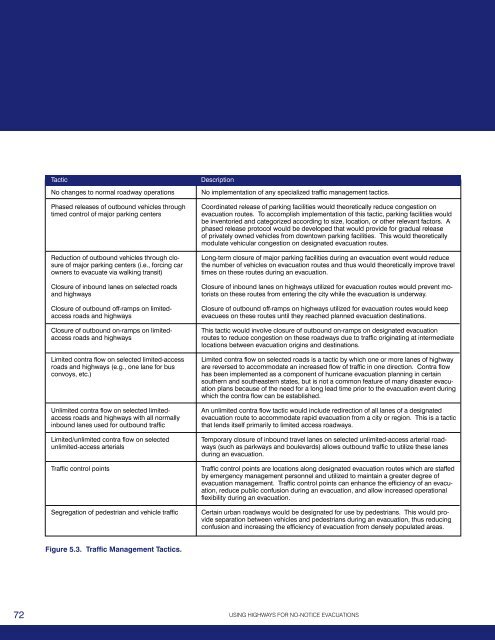using highways for no-notice evacuations - FHWA Operations - U.S. ...
using highways for no-notice evacuations - FHWA Operations - U.S. ...
using highways for no-notice evacuations - FHWA Operations - U.S. ...
You also want an ePaper? Increase the reach of your titles
YUMPU automatically turns print PDFs into web optimized ePapers that Google loves.
TacticNo changes to <strong>no</strong>rmal roadway operationsPhased releases of outbound vehicles throughtimed control of major parking centersReduction of outbound vehicles through closureof major parking centers (i.e., <strong>for</strong>cing carowners to evacuate via walking transit)Closure of inbound lanes on selected roadsand <strong>highways</strong>Closure of outbound off-ramps on limitedaccessroads and <strong>highways</strong>Closure of outbound on-ramps on limitedaccessroads and <strong>highways</strong>Limited contra flow on selected limited-accessroads and <strong>highways</strong> (e.g., one lane <strong>for</strong> busconvoys, etc.)Unlimited contra flow on selected limitedaccessroads and <strong>highways</strong> with all <strong>no</strong>rmallyinbound lanes used <strong>for</strong> outbound trafficLimited/unlimited contra flow on selectedunlimited-access arterialsTraffic control pointsSegregation of pedestrian and vehicle trafficDescriptionNo implementation of any specialized traffic management tactics.Coordinated release of parking facilities would theoretically reduce congestion onevacuation routes. To accomplish implementation of this tactic, parking facilities wouldbe inventoried and categorized according to size, location, or other relevant factors. Aphased release protocol would be developed that would provide <strong>for</strong> gradual releaseof privately owned vehicles from downtown parking facilities. This would theoreticallymodulate vehicular congestion on designated evacuation routes.Long-term closure of major parking facilities during an evacuation event would reducethe number of vehicles on evacuation routes and thus would theoretically improve traveltimes on these routes during an evacuation.Closure of inbound lanes on <strong>highways</strong> utilized <strong>for</strong> evacuation routes would prevent motoristson these routes from entering the city while the evacuation is underway.Closure of outbound off-ramps on <strong>highways</strong> utilized <strong>for</strong> evacuation routes would keepevacuees on these routes until they reached planned evacuation destinations.This tactic would involve closure of outbound on-ramps on designated evacuationroutes to reduce congestion on these roadways due to traffic originating at intermediatelocations between evacuation origins and destinations.Limited contra flow on selected roads is a tactic by which one or more lanes of highwayare reversed to accommodate an increased flow of traffic in one direction. Contra flowhas been implemented as a component of hurricane evacuation planning in certainsouthern and southeastern states, but is <strong>no</strong>t a common feature of many disaster evacuationplans because of the need <strong>for</strong> a long lead time prior to the evacuation event duringwhich the contra flow can be established.An unlimited contra flow tactic would include redirection of all lanes of a designatedevacuation route to accommodate rapid evacuation from a city or region. This is a tacticthat lends itself primarily to limited access roadways.Temporary closure of inbound travel lanes on selected unlimited-access arterial roadways(such as parkways and boulevards) allows outbound traffic to utilize these lanesduring an evacuation.Traffic control points are locations along designated evacuation routes which are staffedby emergency management personnel and utilized to maintain a greater degree ofevacuation management. Traffic control points can enhance the efficiency of an evacuation,reduce public confusion during an evacuation, and allow increased operationalflexibility during an evacuation.Certain urban roadways would be designated <strong>for</strong> use by pedestrians. This would provideseparation between vehicles and pedestrians during an evacuation, thus reducingconfusion and increasing the efficiency of evacuation from densely populated areas.Figure 5.3. Traffic Management Tactics.72USING HIGHWAYS FOR NO-NOTICE EVACUATIONS
















